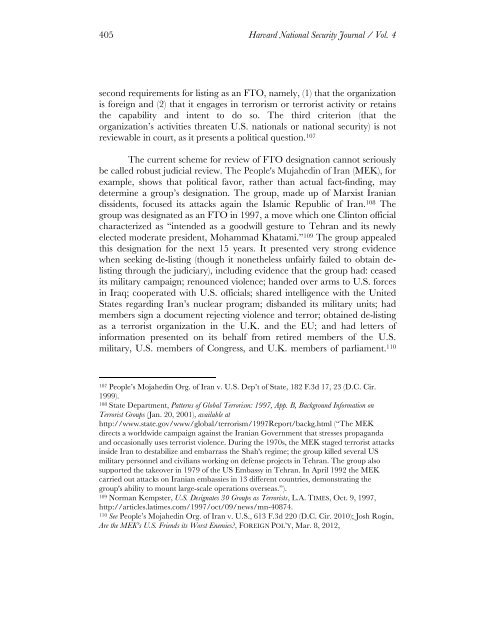Vo.4-Moshirnia-Final
Vo.4-Moshirnia-Final
Vo.4-Moshirnia-Final
You also want an ePaper? Increase the reach of your titles
YUMPU automatically turns print PDFs into web optimized ePapers that Google loves.
405 Harvard National Security Journal / Vol. 4<br />
second requirements for listing as an FTO, namely, (1) that the organization<br />
is foreign and (2) that it engages in terrorism or terrorist activity or retains<br />
the capability and intent to do so. The third criterion (that the<br />
organization’s activities threaten U.S. nationals or national security) is not<br />
reviewable in court, as it presents a political question. 107<br />
The current scheme for review of FTO designation cannot seriously<br />
be called robust judicial review. The People's Mujahedin of Iran (MEK), for<br />
example, shows that political favor, rather than actual fact-finding, may<br />
determine a group’s designation. The group, made up of Marxist Iranian<br />
dissidents, focused its attacks again the Islamic Republic of Iran. 108 The<br />
group was designated as an FTO in 1997, a move which one Clinton official<br />
characterized as “intended as a goodwill gesture to Tehran and its newly<br />
elected moderate president, Mohammad Khatami.” 109 The group appealed<br />
this designation for the next 15 years. It presented very strong evidence<br />
when seeking de-listing (though it nonetheless unfairly failed to obtain delisting<br />
through the judiciary), including evidence that the group had: ceased<br />
its military campaign; renounced violence; handed over arms to U.S. forces<br />
in Iraq; cooperated with U.S. officials; shared intelligence with the United<br />
States regarding Iran’s nuclear program; disbanded its military units; had<br />
members sign a document rejecting violence and terror; obtained de-listing<br />
as a terrorist organization in the U.K. and the EU; and had letters of<br />
information presented on its behalf from retired members of the U.S.<br />
military, U.S. members of Congress, and U.K. members of parliament. 110<br />
107 People’s Mojahedin Org. of Iran v. U.S. Dep’t of State, 182 F.3d 17, 23 (D.C. Cir.<br />
1999).<br />
108 State Department, Patterns of Global Terrorism: 1997, App. B, Background Information on<br />
Terrorist Groups (Jan. 20, 2001), available at<br />
http://www.state.gov/www/global/terrorism/1997Report/backg.html (“The MEK<br />
directs a worldwide campaign against the Iranian Government that stresses propaganda<br />
and occasionally uses terrorist violence. During the 1970s, the MEK staged terrorist attacks<br />
inside Iran to destabilize and embarrass the Shah's regime; the group killed several US<br />
military personnel and civilians working on defense projects in Tehran. The group also<br />
supported the takeover in 1979 of the US Embassy in Tehran. In April 1992 the MEK<br />
carried out attacks on Iranian embassies in 13 different countries, demonstrating the<br />
group's ability to mount large-scale operations overseas.”).<br />
109 Norman Kempster, U.S. Designates 30 Groups as Terrorists, L.A. TIMES, Oct. 9, 1997,<br />
http://articles.latimes.com/1997/oct/09/news/mn-40874.<br />
110 See People’s Mojahedin Org. of Iran v. U.S., 613 F.3d 220 (D.C. Cir. 2010); Josh Rogin,<br />
Are the MEK’s U.S. Friends its Worst Enemies?, FOREIGN POL’Y, Mar. 8, 2012,
















